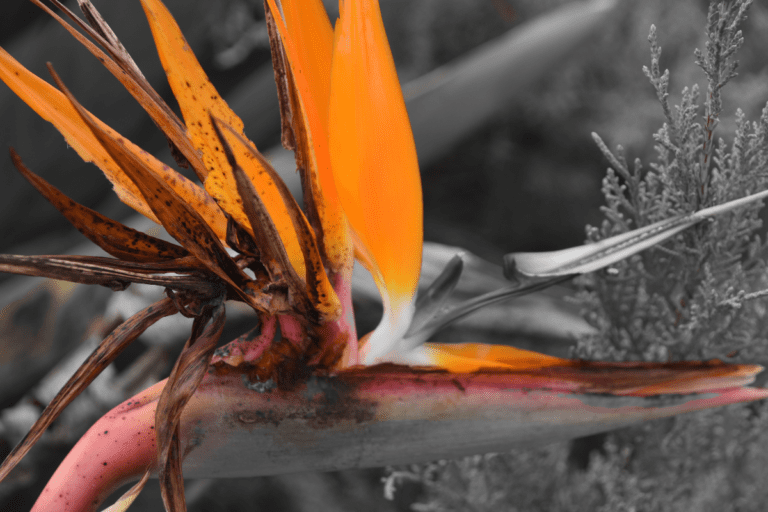How To Revive A Dying Croton Plant? (Possible Problems+Fix)
Croton is a popular houseplant with colorful leaves. However, it is not unusual to see it under stress and struggling to survive.
So today, let’s find out how to revive a dying croton plant.
Your croton might be dying due to underwatering, overwatering, too intense sunlight exposure, pest infestations, and more reasons as such.
To revive dying croton, move the plant to a bright light spot and water the plant before the soil dries out completely. Also, make sure you use well-draining soil along with a pot that has enough drainage holes. Misting the plant to create a humid climate also helps the plant recover the stress.
So, once you know the reason, you can take the actions mentioned in this article. Let’s check all the possible reasons and solutions to help you revive your croton plant.

Please note: Simplify Plants is reader-supported. Some links in the post are affiliate links and I get a commission from purchases made through links in the post.
Why is my croton dying?
A croton plant doesn’t die one fine day.
If the plant is facing issues, it will show you different signs.
You need to determine the problem and the causes with the help of those signs.
If your croton is dying or under stress, you will notice the following signs:
- Discolored leaves
- Distorted foliage
- Foul-smelling soil
- Stunted growth
Now, let’s understand the causes of the problems mentioned above.
How to revive a croton plant?
The best way to revive croton is to understand the reason behind the plant’s trouble.
Most problems that you will see on your croton are either due to unfavorable conditions or incorrect care.
Let’s understand the most common issues along with their solutions.
Croton dying due to overwatering
Watering any plant can be tricky.
Not only beginners but also experts make mistakes in this field.
Crotons prefer moist soil, and to maintain that, you need to water it whenever the top 2 inches go dry.
But if you have followed a watering routine blindly, you might have overwatered your croton.
Possible issues:
- Yellow or brown leaves
- Stunted growth
- Falling leaves
- Root rot
- Pest infestation
- Fungal and bacterial diseases
How to revive overwatered croton?
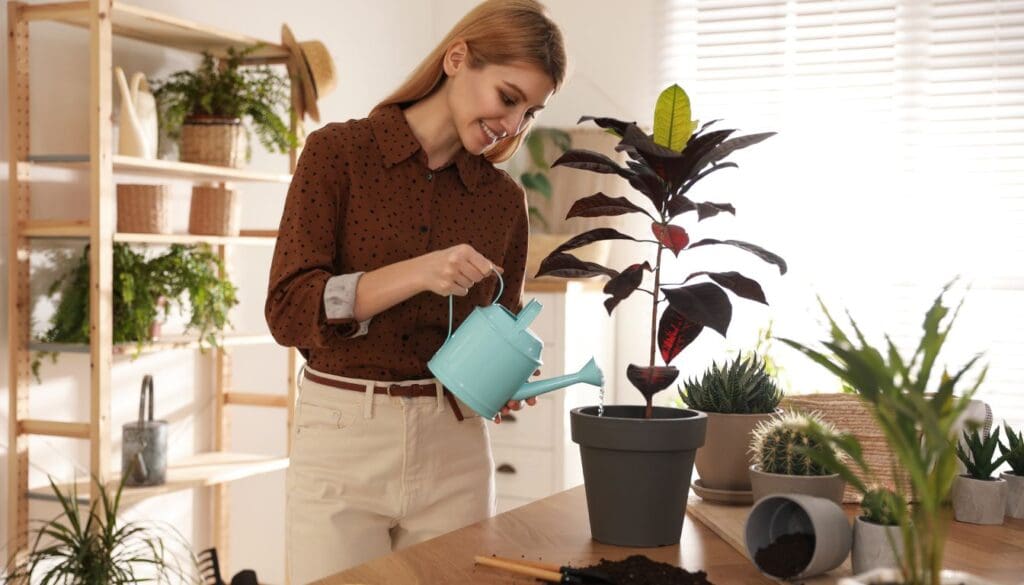
You can rescue your croton from overwatering with these steps:
- Stop watering immediately.
- Place the croton in a bright spot and let the soil dry.
- If you notice standing water, tilt the pot to get rid of the water.
- Prune all the discolored leaves.
- Take the croton out of the pot to inspect the roots.
- If you notice decaying roots, prune them with a sterilizer pruner.
- Apply fungicide and repot the croton in fresh soil and new pot.
Prevent overwatering:
- Don’t follow any watering schedule blindly.
- If you want to prevent this situation, check the soil before watering.
- Water the croton only when the topsoil is dry.
- You can get a moisture meter to determine the moisture of the soil.
- Use a pot with drainage holes and let the excess water drain out every time you water it.
- Ensure the soil has elements that support excess water drainages, such as sand or perlite.
- Empty the cache tray regularly to avoid letting the plant sit on the water.
Also read: How To Save Overwatered Croton Plant? (Signs, Problems & Solution)
Croton dying due to underwatering
Your croton can get stressed if you don’t provide sufficient water.
Since crotons enjoy moist soil, it requires water before the soil goes entirely dry.
But if you often forget to water your houseplants, you might be keeping the croton thirsty for too long.
Possible issues:
- Crispy brown leaves
- Dehydrated plant
- Dry soil
- Droopy leaves
- Falling leaves
How to revive overwatered croton?

If you have an underwatered croton, you can revive it easily with the following steps.
- First, you can take the croton out of the pot and soak the soil in a container filled with water.
- Or, you can take a stick and poke the soil if it has become compact. This will aerate the soil and help it absorb the water.
- Start by providing a little water to your croton and wait for the soil to soak that water.
- Once the water is absorbed, you can water the plant thoroughly.
- You can prune the crispy leaves but not the droopy leaves as they will return to health once the plant recovers.
Prevent underwatering:
- Use a calendar to help you remind that you need to check up on your croton.
- Water the croton immediately if the topsoil feels dry.
- Water the plant thoroughly every time you water it.
- You can use a self-watering pot if you don’t get time to water your plants.
Also read: How Often To Water Croton Plant? (Watering Schedule+Watering Problems)
Croton dying due to low temperatures
Croton is a tropical plant and prefers warm conditions, not low temperatures.
If you live in the colder regions or experience freezing winters, your croton can undergo stress.
If you left your croton outside and exposed it to low temperature, the plant might get damaged.
Some signs of such stress are:
- Brown spots on leaves
- Shriveled leaves
- Stunted growth
- Weak plant
How to revive croton exposed to low temperatures?
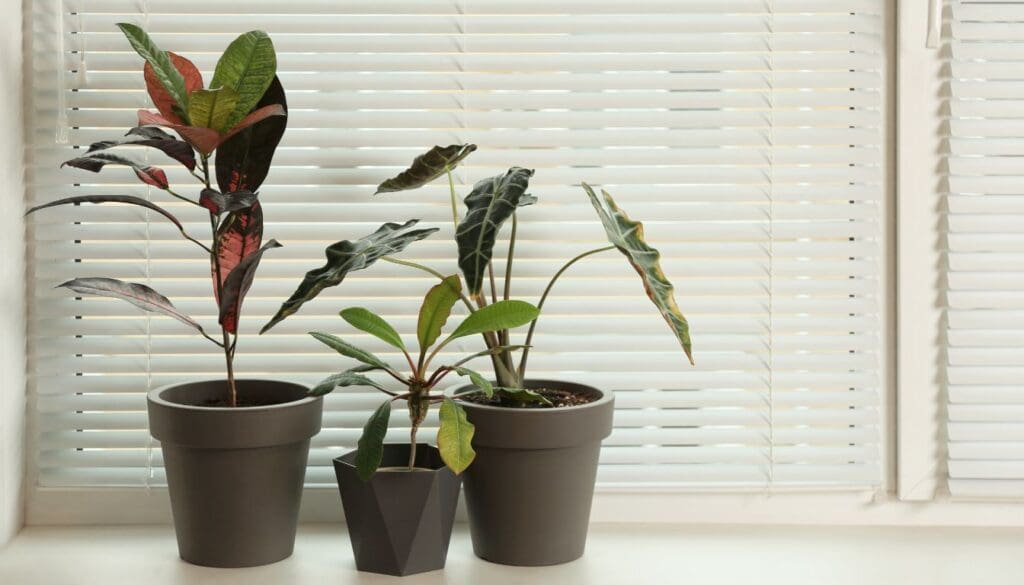
If your croton is dying due to being left under low temperatures, do these:
- Bring your croton indoors if it is outside.
- Keep the croton in a warm room with the ideal temperatures for the plant.
- Don’t keep croton near frosty windows.
- Avoid keeping the croton near windows that are opened and closed too frequently.
- If the temperatures go below 40°F, you can move your croton to a warmer location.
Prevention:
- If you want to keep your croton safe from low temperatures, maintain the ideal temperatures, which fall between 65-80°F.
- If your croton is outside, bring it inside during winter when the temperatures go low.
Also read: What Temperature Can Croton Tolerate? (+Ideal Temperature Range)
Croton dying due to low light
Crotons are not low-light houseplants.
Crotons prefer full sun to bright indirect light, but they will not react well to low light.
It is not unusual for the croton to fall ill if it doesn’t get enough light.
Signs of low light are:
- Leggy growth
- Discolored leaves
- Pest infestation
- Slow or no growth
How to revive croton not getting enough light?
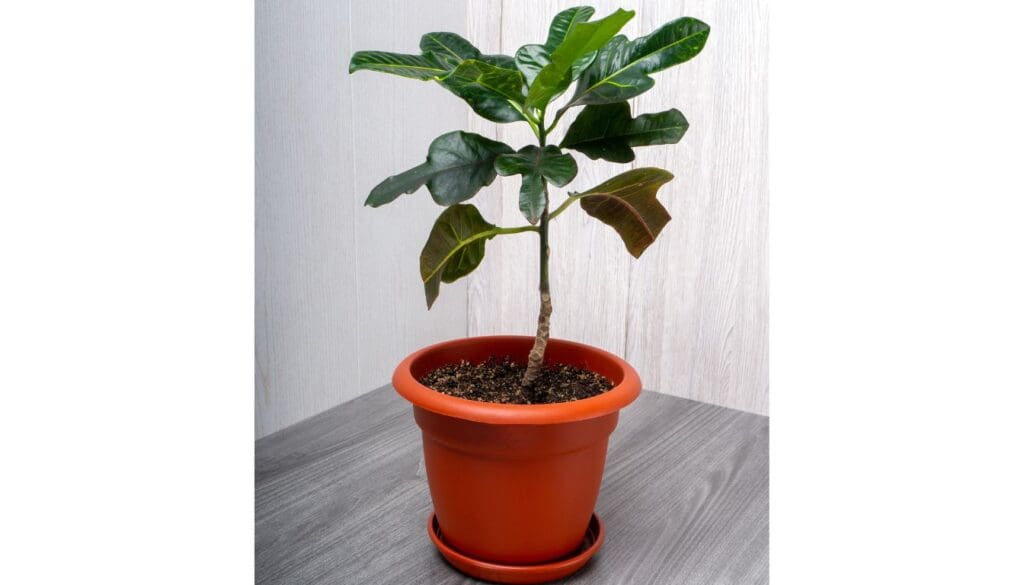
If your croton doesn’t get enough light:
- Find a brighter spot for the croton and shift it there.
- If there is any leggy growth, prune those.
- If your house doesn’t get enough natural light, use artificial lights.
Also read: What Kind Of Light Does A Croton Need? (Croton Light Requirements )
Croton dying due to too intense light
Many croton species prefer full sun, but that doesn’t mean you can leave the plant exposed to the intense sunlight of afternoons.
If your croton is exposed to intense direct sunlight, the plant will experience sunburn and stress.
Signs of sunburned croton are:
- Brown spots or entirely brown leaves
- Crisp leaves
- Dry and compact soil
- Dehydrated plant
How to revive sunburned croton?

Sunburn can cause severe stress to crotons. But you can revive the plant if you:
- Change the location of your croton and put it in a spot where it doesn’t get hit by the intense sunlight.
- You can prune the damaged leaves as they are unlikely to become healthy.
- Bring it a few feet away from the window if your croton is placed in front of a window.
- If your croton is placed outside, keep it in a spot that doesn’t get direct intense sunlight.
Prevent causing sunburn on croton:
- Avoid keeping the croton outside, especially when the sun is too intense.
- Relocate the plant in the afternoons when the sunlight is too intense.
Also read: Can Crotons Get Too Much Sun? (Sunburn?)
Croton dying due to low humidity
Coming from tropical regions, crotons prefer high humidity, and low humidity can become a big problem if it persists for too long.
If the croton doesn’t get enough humidity, it will become dehydrated and stressed.
Brown and crispy leaves are the sign of croton experiencing low humidity.
How to revive croton experiencing low humidity?

Increasing the humidity is the way to deal with croton that didn’t get enough humidity.
There are different ways of raising the humidity.
- Install a humidifier and place your croton near it.
- If you have an aquarium, keep your croton near it.
- Use a pebble tray to raise the humidity for your croton.
- Mist croton to give a boost of humidity.
- Group your croton with other moisture-loving plants.
Also read: Do Crotons Need Misting? (+Maintaining Ideal Humidity)
Croton dying to transplant shock
Crotons don’t prefer frequent changes, and repotting can cause a lot of stress for the plant.
If you repot your croton in the fall or winter season, the stress rate might be more than repotting during the growing season.
Signs of transplant shock on the croton are:
- Falling leaves
- No growth
How to revive the croton stressed due to transplant shock?
Although crotons can undergo stress after repotting, you can revive the plant by taking care of the plant.
If you provide the correct temperature, humidity, light, and water to the plant, it will soon recover from the stress.
Also, try not to repot the plant during fall or winter, unless urgent.
Since summer and spring are the growing seasons for the croton, repotting during this time can cause less stress to the plant.
Also read: When Can You Repot Croton Plant? (+How To Repot)
Croton dying due to pest infestations
Pests are highly damaging as they suck the nutrients out of the plants.
If your croton has a pest infestation, you can expect to see a lot of signs on the plant.
- Falling leaves
- Spots on leaves
- Shriveled leaves
How to revive pest-infested croton?
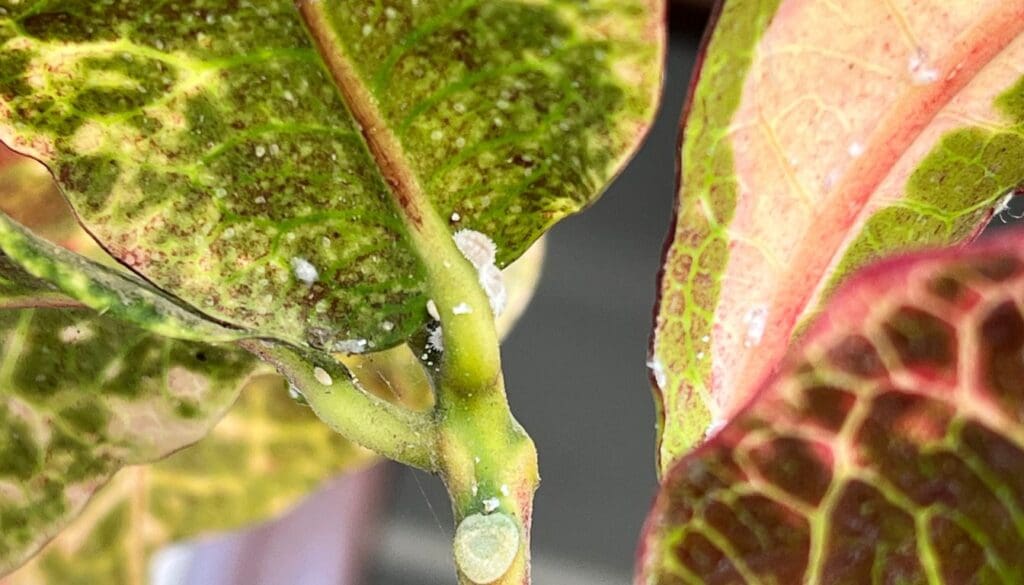
If your croton is infested with pests, here is what you should do:
- Isolate the croton as soon as you find out it has a pest infestation.
- If you can see the pests, handpick them.
- Immerse a cotton ball in rubbing alcohol and wipe the affected areas.
- Prune the parts of the croton that are heavily infected.
- Start the treatment by spraying a neem oil solution on the croton.
- Spray thoroughly all over the croton as pests can hide in any corner.
- Spray every day till the pests are gone.
- Continue the spraying every evening and wash it off in the morning.
Prevent pests on crotons:
- Spray a neem oil solution on your croton once a month to keep pests away.
- Inspect your croton every few days to ensure it does well and doesn’t have any pests.
- Avoid overwatering the croton as it will invite pests such as aphids, mealybugs, and scales.
- Avoid keeping the croton thirsty or dry as it will invite pests like spider mites.
Also read: How Do I Get Rid Of Bugs In My Croton Plant? (Common Bugs+Fix)
Do crotons grow back?
Even if your croton is going through severe stress, you can always bring it back with some care.
If you can identify the problem, you can fix it.
But if you know the correct care methods for your croton, you can prevent many of the problems mentioned above.
I am sharing some essential care tips for the croton plants.
- Provide 6-8 hours of full sunlight or indirect bright sunlight to your croton, depending on its species.
- Maintain warm temperatures between 65-80°F around your croton.
- Provide proper humidity of at least 40% with the help of misting, a humidifier, a pebble tray, or by grouping the croton with humidity-loving plants.
- Water the croton when the top 1-2 inches of the soil feel dry upon touching.
- Use soil that will drain the extra water and keep the required moisture. You can mix peat moss and compost and use it for the croton.
- Use a liquid fertilizer with an NPK of 3:1:2 to fertilize the croton once a month during the growing season.
- Spray a neem oil solution on your croton every month to prevent pest infestations.
- Clean the leaves of the plant to ensure that they remain dust-free.
- Rotate the croton now and then so that it gets light on all sides.
- Reduce watering and fertilizing when winter approaches.
- Keep checking the croton to identify any issue during the initial phase and treat it fast.

Reference: Sciencedirect, Wikipedia, Wikipedia, Britannica, CABI, Academia, University of South Florida, The University of Georgia.
Recommended Garden Supplies
| Product Image | Our Recommended Gardening Supplies | Check Offers! |
|---|---|---|
Top Top
Top
Top
Top
Top
Top
Top
Top | rePotme Houseplant and Tropical Classic Potting Soil Mix | Check Offer On Amazon |
 Top
Top
Top
Top
Top
Top
Top
Top | Espoma Organic Indoor Plant Food | Check Offer On Amazon |
 Top
Top
Top
Top
Top
Top
Top
Top | GooingTop LED Grow Light 6000K Full Spectrum Clip Plant Growing Lamp | Check Offer On Amazon |
 Top
Top
Top
Top
Top
Top
Top
Top | Soil Moisture Meter | Check Offer On Amazon |
 Top
Top
Top
Top
Top
Top
Top
Top | Govee Hygrometer Thermometer, Bluetooth Enabled! | Check Offer On Amazon |
 Top
Top | LEVOIT Humidifiers for Large Room(Best For Plants) | Check Offer On Amazon |
 Top
Top
Top
Top
Top
Top
Top
Top | Upgraded DIY Automatic Drip Irrigation Kit, 15 Potted Houseplants Support | Check Offer On Amazon |
 Top
Top
Top
Top
Top
Top
Top
Top | Stainless Steel Heavy Duty Gardening Tool Set | Check Offer On Amazon |
 Top
Top
Top
Top
Top
Top
Top
Top | Bonide Insecticidal Soap | Check Offer On Amazon |
 Top
Top
Top
Top
Top
Top
Top
Top | Bonide 32 oz Spray Neem Oil for Organic Gardening | Check Offer On Amazon |
 Top
Top
Top
Top
Top
Top
Top
Top | Garden Safe Fungicide | Check Offer On Amazon |





